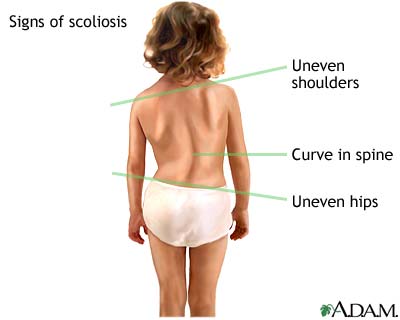Scoliosis explained
Scoliosis is a sideways curve of the spine that causes stiffness and pain. It is called an idiopathic disease because the cause of it is unknown. Scoliosis is more common in females and begins in childhood. However, merely 2 percent of the population is afflicted. If it is detected early, scoliosis treatment will prevent it from worsening over time.
Scoliosis is derived from the Greek term meaning curvature. People with scoliosis have a sideways curve in their spine that makes an “S” or “C” shape. The vertebrae can rotate at the thoracic (mid-back) level of the spine causing this curve and resulting in a hump near the rib cage. If the curve is more than 60 degrees it is considered serious. Usually this curve makes the waist or shoulders uneven. And unlike the normal curvature of the spine, adjusting your posture will not correct the problem.
As you age, if the spinal curve is not corrected there will be more pressure on the discs, spine and muscles and you may develop scar tissue!
In some instances, the degenerative diseases of the spine can cause scoliosis. Osteoporosis is when the bones soften and this usually occurs in older people. This softening can cause the vertebrae to bend and shape the curve causing scoliosis or kyphosis (increased rounding in the mid-back). If not treated properly, severe back pain, deformity, and difficulty breathing can be some symptoms that will arise.
If you have Scoliosis/spinal curve it can lead to arthritis in the back later in life if it is not taken care of!
Treatments for Scoliosis
When someone is diagnosed with Scoliosis or a spinal curve often several types of treatments are required to aid in resolving the causes of the spinal curve. The treatments for this curve are dependant on the extent of the abnormal curve in the spin. Treatments can range from: Chiropractic for the spinal curve, Active release technique for the muscles adhesions/ scar tissue, massage, postural advise, stretches for the shortened muscle side, strengthening for the weakened muscle side, and sometimes bracing is needed during the spinal alignment phase. In some cases surgery is required.
Chiropractic Care for Scoliosis
Chiropractic care can help improve this condition. A chiropractor looks at your overall health examining your spine as well as other factors of your lifestyle. To help identify the problem’s cause, Dr. Barbara Rodwin will discuss symptoms and previous injuries, your family’s health history, and recreational and work-related activities.
Palpation, orthopedic, and neurological tests will be performed as well as x-rays may be ordered to determine the extent.
Most exams for scoliosis include the Adam’s Forward Bending Test. It requires the person to bend at the waist as someone views the spinal alignment. If there is an abnormal prominence or hump you should look into treatment. Dr. Rodwin will measure the length of the legs to determine unevenness, perform a range of motion test that measures the degree to which the patient has mobility at the waist, orthopedic, muscle and vertebral joint testing.
If needed, Dr. Rodwin will refer you to a specialist for further scoliosis treatment.
Regular visits to your chiropractor, to observe the progression of scoliosis, are an integral part of living a full and happy life. Scoliosis can be treated in various ways to help alleviate pain and restore normal functionality. Advise is given for postural changes, stretches are given to stretch the shortened side and strengthening exercises are given to aid in restoring the curve.
Signs of Scoliosis/Spinal Curve
1. Uneven shoulders
2. One side of the chest/abdomen being bigger
3. One hip higher than the other
4. If you hem one pant leg higher.
5. One side of the ribs are rotated
6. Uneven musculature on one side of the spine.


